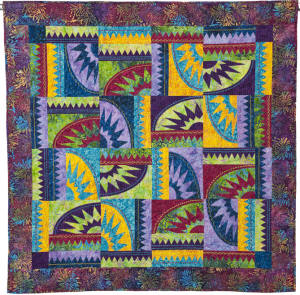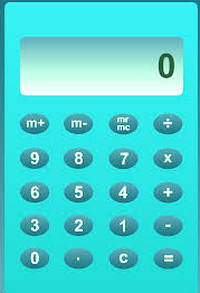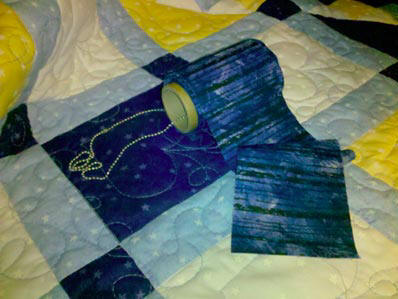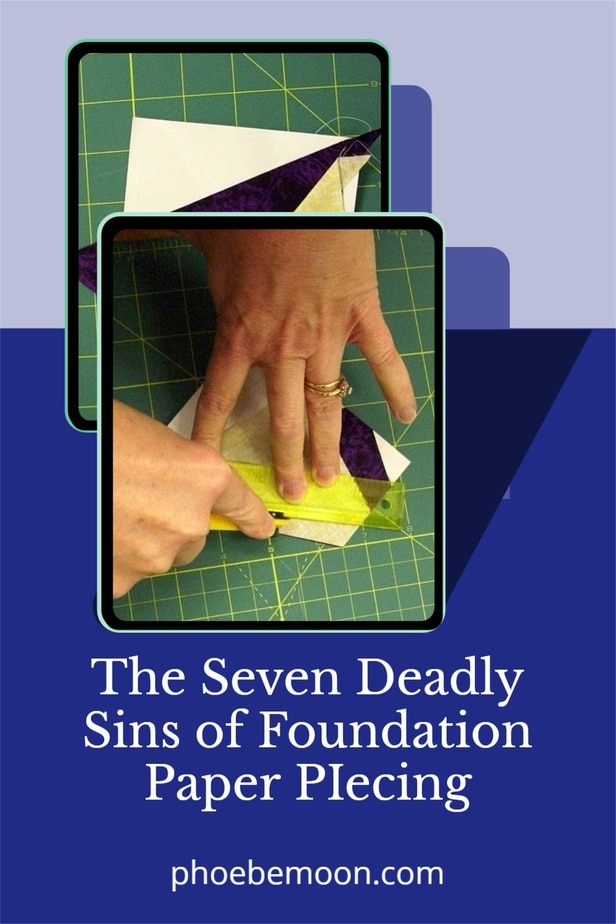*This post MAY contain affiliate links. That means that if you make a purchase after clicking on a link I may earn a small commission at no extra cost to you. I don’t ever recommend something that I don’t use myself. Not all links are affiliate links. For more information, see our Privacy Policy.
The Seven Deadly Sins of Foundation Paper Piecing
How to Learn to Paper Piece without Tearing Out Your Hair
Foundation piecing is the technique of sewing fabric to a foundation in order to achieve very precise results. The foundation can be fabric and left in place, or it can be paper to be removed later. Paper pieced patterns are usually small and give you the opportunity to use up your small scraps leftover from other projects. Patterns pieced to a fabric foundation are usually a bit larger and easier to use. A fabric foundation pieced block is a good way to learn the technique.
The table runner below was made by Tamara using Foundation by the Yard. If you would like to read her tutorial on foundation piecing the Christmas Star Tablerunner, click here.
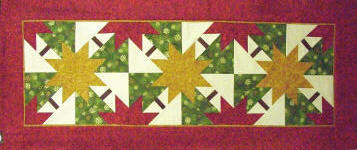
Learning to paper piece is like learning ballroom dancing. You have to perform all your steps in a certain order while dancing backward in high heels and checking your progress in a mirror. Expect to make a lot of mistakes while learning! In fact, I tell students they aren’t True Paper Piecers unless they have committed at least one of the seven deadly sins (mistakes) at least once.
Paper pieced patterns are printed with the numbered steps printed on the back of the paper. You place the fabric on the front of the paper, then turn the paper over and sew on a numbered line. It helps to have a focused light source so you can see through the paper and get a good idea of where to place the fabric. It won’t need to be exact as you will trim it later.
Here’s a hint from Dorothy: “I use a rotary wheel that has spikes around the edge – it was originally for “tracing” paper dress patterns. I roll each line on the pattern about 4 at a time so that it folds easily and perfectly, and rips out easy peasy”
Tools for Learning to Paper Piecing
If you are just learning, why don’t you gather these tools now?
• A strong light source, like an Ott-Lite or a Bendable Bright Light that attaches to your sewing machine
• An add-a-quarter or add-an-eighth ruler to trim seams
• Size 14 (denim) needles for your machine
• Very thin pins or a washable glue stick to hold your fabric in place momentarily
• A seam ripper
• A small iron – not a steam iron. A wooden one will work.
• A 4 ½” square ruler
• A small mat and 18mm or 28mm rotary cutter
• Scotch Brand removable magic tape to repair rips in the paper. This tape won’t melt under the heat of the iron and is easily removed.
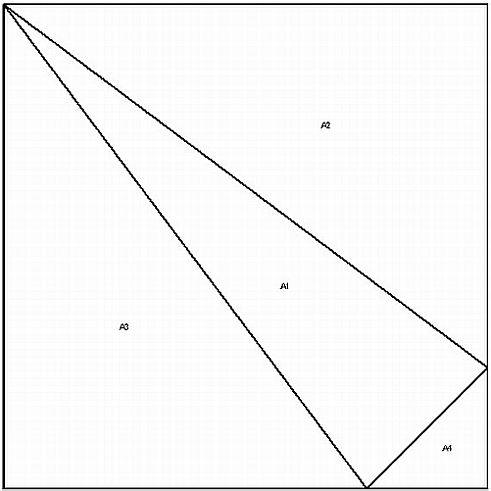
Let’s do an easy block. Print out or trace this pattern on foundation piecing paper or wash-away paper if you have it. (Double-check the size of the block – it should print out at 4″ square (finished) with the angle of the centerpiece exactly 1″ from the lower right corner.)
You can also use tracing paper, blank newsprint, or other thin paper. If all you have is computer paper, that will work, but add tweezers to your list as you will need them to pull out small bits of paper. Put a new large needle in your machine and set the stitch length to very, very small. This helps you perforate the paper later. You are going to be sewing on a thin line – make sure the foot on your machine will let you see that line.
Prewash your fabric. You don’t want to do all this work and then have your fabric shrink and/or run. Don’t worry too much about grainline when paper piecing. Keep it in mind and try to honor it, but don’t let it stress you out if you are using scraps. Directional fabrics are another concern. Check on how they will look in the final product before investing too much time in the block.
Placing the Fabric
Place the first fabric piece (A1 in the diagram) roughly in the middle of the pattern on the side that does NOT have the lines. This is going to be the front of the block, so the first piece of fabric must be right-side up. Use a thin pin or a dab from a glue stick to hold it in place. Take the second piece of fabric (A2 in the diagram) and place it right side down on the first piece with the cut edge at least 1/4″ to the right of the line of the back.
See why a strong light source is a good thing? You need to be able to see through the paper and two layers of fabric.
Sew on the line. Go back to the front of the block and flip the second fabric over so it hides the seam.
Opportunities to sin:
Here is your chance to commit several of the deadly sins and get them out of the way! You can:
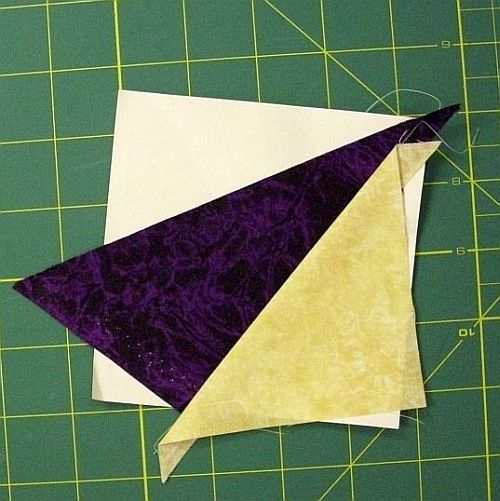
• place the second fabric the wrong way so it doesn’t fit the block when you flip it over (see picture above. I meant to do that.)
• put the wrong side of the fabric up (or down)
• sew on the wrong line
If you haven’t made any of these errors, don’t worry, here is another chance. Fold the first and second fabrics as well as the paper underneath so you can trim the seam allowance as shown in the picture below. The add-a-quarter ruler has a little lip on it that helps hold everything in place.
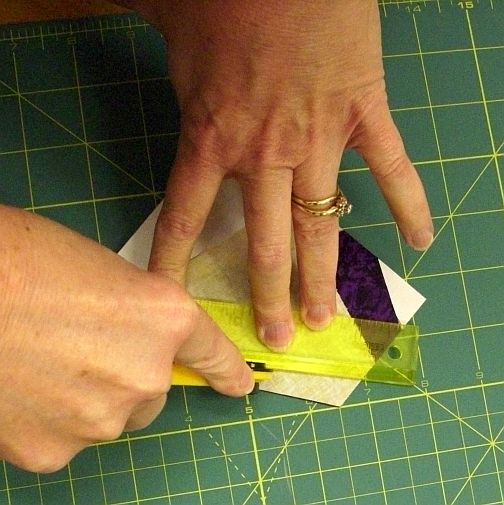
More opportunities to sin:
- • cutting the fabric piece instead of the seam allowance
- • cutting the paper pattern (see the picture below.)
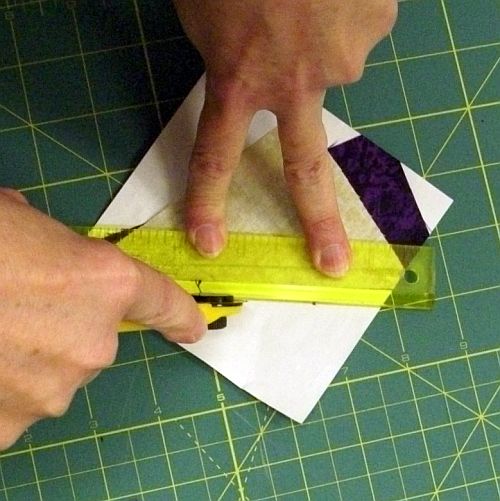
If all has gone well, flip your block back to the front and press using your choice of iron. You may prefer to trim your seam allowances before cutting. Cleary of CieAngels Haven offered this tip: “Put a card against the line you are getting ready to sew (picture 1) and fold the paper back over the card. (picture 2) Butt your 1/4 or 1/8 ruler up to it then trim for the seam. (picture 3) It helps keep everything in line.” She sent the pictures below to illustrate this technique.
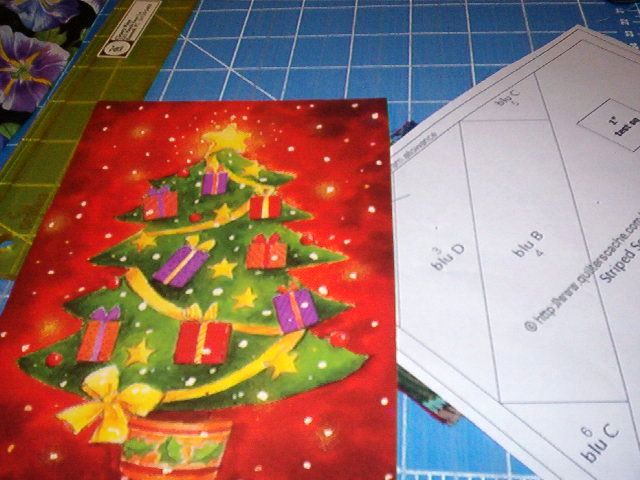
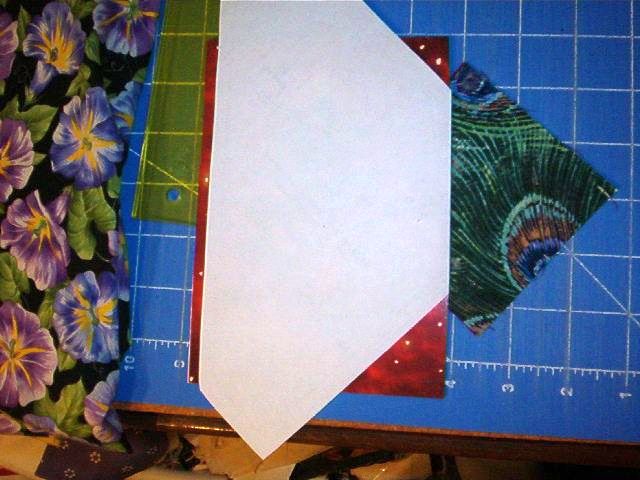
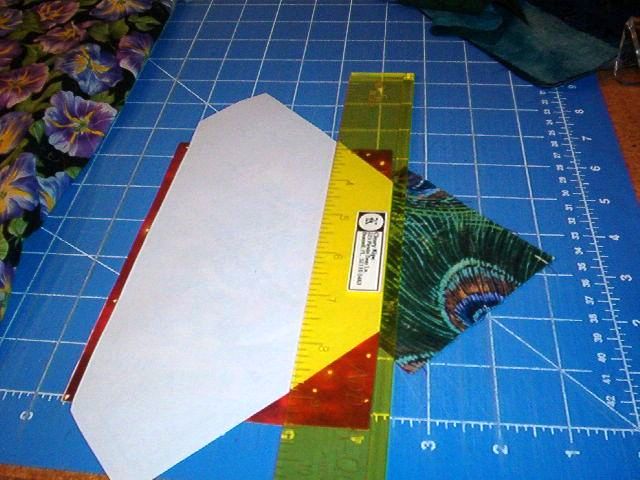
Now you need to add the third piece of fabric (A3 in the diagram). Notice that A3 is actually the reverse of A2. (Some patterns will refer to this pattern piece as A2R.) Lay a piece of fabric right side down with the cut edge to the left. Turn the block over and sew on the line. Turn the block back to the front, flip the fabric over and look at your block.
If you did not pin or glue stick the A2 fabric in place, you have given yourself the opportunity to commit the last sin: catching one fabric piece in the seam allowance of another. This can be difficult to fix, so don’t forget to pin!
Still okay? If so, trim the seam allowance to 1/4″ (or even 1/8″ if you prefer.) If not, put a checkmark beside the sin you committed and heave a sigh of relief. You got that one out of the way! Get out your seam ripper and fix it. Or… make a whole new block. No one is watching! Sometimes it’s easier to just start over rather than try to fix a tiny error.
The last piece (A4) is the smallest – and your last opportunity to make a mistake! Once you have finished, press the block from the front and square it up to 4 ½” (including the seam allowance.) Don’t remove the paper just yet. Make three more blocks first, then practice setting them together. Theoretically, they should go together perfectly to make a crisp square in the center. Don’t use your really, really small stitch to sew them together the first time – If you need to unpick the seam and redo it, you will regret not having changed it. (Ask me how I know…)
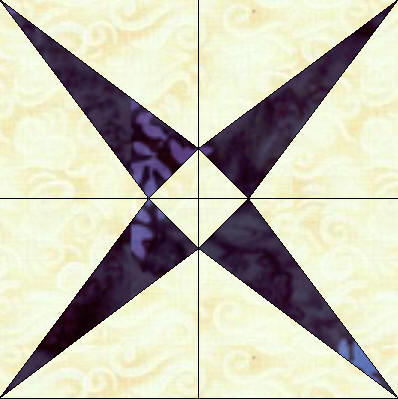
Once you have all four blocks together and are satisfied with the final block, you can use your seam ripper to pull out the paper. Press your block joining seams in opposite directions to reduce bulk, just as you would with a regular four patch.
Here are the Seven Deadly Sins you must commit before calling yourself a True Paper Piecer:
• Placing the fabric wrong side up
• Not following the design – putting the fabric in the wrong place. Sometimes this is caused by not realizing you are working on a mirror image block.
• Placing the fabric the wrong way so it doesn’t fit the block when you flip it over
• sewing on the wrong line
• cutting the fabric piece instead of the seam allowance
• cutting the paper pattern
• catching one fabric piece in the seam allowance of another.
Incidentally, Anita Grossman Solomon invented a sinfully good technique to “fold and sew” paper piecing. Video links to her paper piecing segments on HGTV’s Simply Quilts are on her blog https://makeitsimpler.blogspot.com
Any tips to add? Send them to me, and I will add them here.


